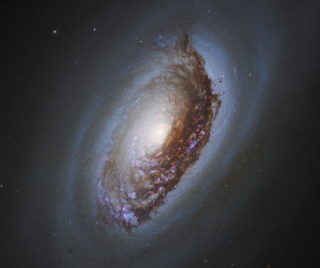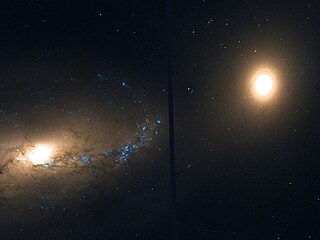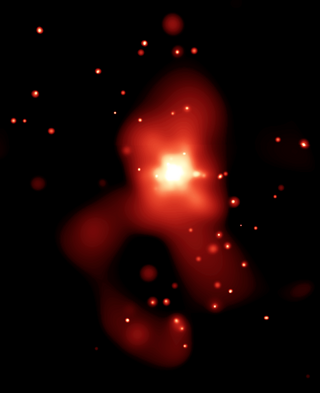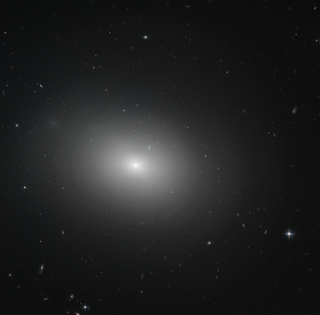
The Black Eye Galaxy is a relatively isolated spiral galaxy 17 million light-years away in the mildly northern constellation of Coma Berenices. It was discovered by Edward Pigott in March 1779, and independently by Johann Elert Bode in April of the same year, as well as by Charles Messier the next year. A dark band of absorbing dust partially in front of its bright nucleus gave rise to its nicknames of the "Black Eye", "Evil Eye", or "Sleeping Beauty" galaxy. M64 is well known among amateur astronomers due to its form in small telescopes and visibility across inhabited latitudes.

The Sombrero Galaxy (also known as Messier Object 104, M104 or NGC 4594) is a peculiar galaxy of unclear classification in the constellation borders of Virgo and Corvus, being about 9.55 megaparsecs (31.1 million light-years) from the Milky Way galaxy. It is a member of the Virgo II Groups, a series of galaxies and galaxy clusters strung out from the southern edge of the Virgo Supercluster. It has a D25 isophotal diameter of approximately 29.09 kiloparsecs (94,900 light-years), making it slightly bigger in size than the Milky Way.

NGC 3227 is an intermediate spiral galaxy that is interacting with the dwarf elliptical galaxy NGC 3226. The two galaxies are one of several examples of a spiral with a dwarf elliptical companion that are listed in the Atlas of Peculiar Galaxies. Both galaxies may be found in the constellation Leo. It is a member of the NGC 3227 Group of galaxies, which is a member of the Leo II Groups, a series of galaxies and galaxy clusters strung out from the right edge of the Virgo Supercluster.

NGC 3226 is a dwarf elliptical galaxy that is interacting with the spiral galaxy NGC 3227. The two galaxies are one of several examples of a spiral with a dwarf elliptical companion that are listed in the Atlas of Peculiar Galaxies. Both galaxies may be found in the constellation Leo. It is a member of the NGC 3227 Group of galaxies, which is a member of the Leo II Groups, a series of galaxies and galaxy clusters strung out from the right edge of the Virgo Supercluster.

NGC 4261 is an elliptical galaxy located around 100 million light-years away in the constellation Virgo. It was discovered April 13, 1784 by the German-born astronomer William Herschel. The galaxy is a member of its own somewhat meager galaxy group known as the NGC 4261 group, which is part of the Virgo Cluster.

NGC 4536 is an intermediate spiral galaxy in the constellation Virgo located about 10° south of the midpoint of the Virgo cluster. However, it is not considered a member of the cluster. Rather, it is a member of the M61 Group of galaxies, which is a member of the Virgo II Groups, a series of galaxies and galaxy clusters strung out from the southern edge of the Virgo Supercluster. The morphological classification in the De Vaucouleurs system is SAB(rs)bc, which indicates it is a weakly barred spiral galaxy with a hint of an inner ring structure plus moderate to loosely wound arms. It does not have a classical bulge around the nucleus.

NGC 4698 is a barred spiral galaxy located around 55 million light years away from Earth in the constellation of Virgo. It belongs to the Virgo Cluster of galaxies and is positioned near the northeastern edge of this assemblage. The morphological classification of NGC 4698 in the De Vaucouleurs system is SA(s)ab, which indicates a purely spiral structure with moderate to tightly wound arms. It is inclined to the line of sight from the Earth by an angle of 53° along a position angle of 170°.

NGC 708 is an elliptical galaxy located 240 million light-years away in the constellation Andromeda and was discovered by astronomer William Herschel on September 21, 1786. It is classified as a cD galaxy and is the brightest member of Abell 262. NGC 708 is a weak FR I radio galaxy and is also classified as a type 2 Seyfert galaxy.

NGC 2336 is a barred spiral galaxy located in the constellation Camelopardalis. It is located at a distance of circa 100 million light years from Earth, which, given its apparent dimensions, means that NGC 2336 is about 200,000 light years across. It was discovered by Wilhelm Tempel in 1876.

NGC 7469 is an intermediate spiral galaxy in the constellation of Pegasus. NGC 7469 is located about 200 million light-years away from Earth, which means, given its apparent dimensions, that NGC 7469 is approximately 90,000 light-years across. It was discovered by William Herschel on November 12, 1784.

NGC 3367 is a barred spiral galaxy located in the constellation Leo. It is located at a distance of about 120 million light years from Earth, which, given its apparent dimensions, means that NGC 3367 is about 85,000 light years across. It was discovered by William Herschel on March 19, 1784.

NGC 7130 is a spiral galaxy located in the constellation Piscis Austrinus. It is located at a distance of about 220 million light years from Earth, which, given its apparent dimensions, means that NGC 7130 is about 100,000 light years across. It was discovered by John Herschel on September 25, 1834, and discovered independently by Lewis Swift on September 17, 1897. The location of the galaxy given in the New General Catalogue was off by 30 arcminutes in declination from the location of the galaxy.

NGC 5982 is an elliptical galaxy located in the constellation Draco. It is located at a distance of circa 130 million light years from Earth, which, given its apparent dimensions, means that NGC 5982 is about 100,000 light years across. It was discovered by William Herschel on May 25, 1788.

NGC 3489 is a lenticular galaxy located in the constellation Leo. It is located at a distance of circa 30 million light years from Earth, which, given its apparent dimensions, means that NGC 3489 is about 30,000 light years across. It was discovered by William Herschel on April 8, 1784. NGC 3489 is a member of the Leo Group.

NGC 4636 is an elliptical galaxy located in the constellation Virgo. It is a member of the NGC 4753 Group of galaxies, which is a member of the Virgo II Groups, a series of galaxies and galaxy clusters strung out from the southern edge of the Virgo Supercluster. It is located at a distance of about 55 million light years from Earth, which, given its apparent dimensions, means that NGC 4636 is about 105,000 light years across.

NGC 5846 is an elliptical galaxy located in the constellation Virgo. It is located at a distance of circa 90 million light years from Earth, which, given its apparent dimensions, means that NGC 5846 is about 110,000 light years across. It was discovered by William Herschel on February 24, 1786. It lies near 110 Virginis and is part of the Herschel 400 Catalogue. It is a member of the NGC 5846 Group of galaxies, itself one of the Virgo III Groups strung out to the east of the Virgo Supercluster of galaxies.

NGC 1386 is a spiral galaxy located in the constellation Eridanus. It is located at a distance of circa 53 million light years from Earth, which, given its apparent dimensions, means that NGC 1386 is about 50,000 light years across. It is a Seyfert galaxy, the only one in Fornax Cluster.

NGC 4278 is an elliptical galaxy located in the constellation Coma Berenices. It is located at a distance of circa 55 million light years from Earth, which, given its apparent dimensions, means that NGC 4278 is about 65,000 light years across. It was discovered by William Herschel on March 13, 1785. NGC 4278 is part of the Herschel 400 Catalogue and can be found about one and 3/4 of a degree northwest of Gamma Comae Berenices even with a small telescope.

NGC 7418 is an intermediate spiral galaxy located in the constellation Grus. It is located at a distance of circa 60 million light-years from Earth, which, given its apparent dimensions, means that NGC 7418 is about 60,000 light-years across. It was discovered by John Herschel on August 30, 1834.

NGC 2273 is a barred spiral galaxy located in the constellation Lynx. It is located at a distance of circa 95 million light years from Earth, which, given its apparent dimensions, means that NGC 2273 is about 100,000 light years across. It was discovered by Nils Dunér on September 15, 1867.




















